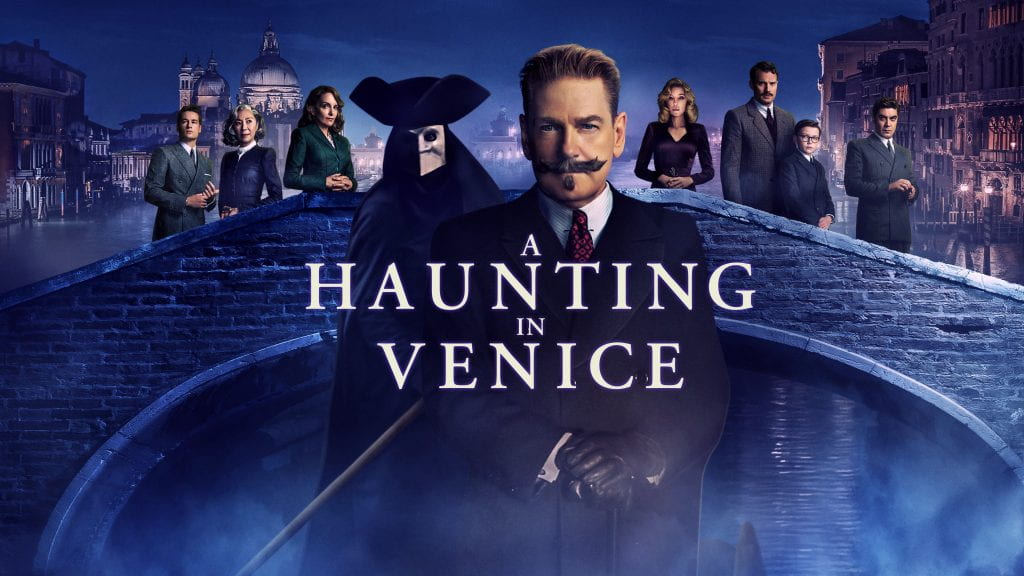by Aelwen Iredale

A murder mystery should not kill its audience with boredom. Unfortunately, that is precisely the fate awaiting watchers of A Haunting in Venice (2023). It is the latest installment of the Agatha Christie film adaptation series written by Michael Green and starring, produced, and directed by Kenneth Branagh. While the first two films, Murder on the Orient Express (2017) and Death on the Nile (2022), were fairly faithful to the books on which they were based, A Haunting in Venice diverges into an original mystery by Michael Green wherein he kills characters and plot in a quite literal murder-for-profit.
A Haunting in Venice is based on Hallowe’en Party, Christie’s original title for the book, but the truth, freely admitted by Green, is that he merely “stole that sparkling, ingenious premise [of] a murder at a Halloween Party.” He took an original idea that evolves into a brilliant novel and twists it into a story filled with cliches. The only link between his screenplay and the original book is that Green’s characters share the names of Christie’s characters, despite the roles being entirely different and omitting the most important characters from the original novel. Of course, any Christie fan or reader of Hallowe’en Party could have anticipated that the mystery would change since the public may not appreciate child murder, but the alterations failed to become what Green hoped would be “something stunning and…new.” In fact, Green’s original content fails to capture a Poirot mystery’s true appeal or Christie’s brilliance, murdering the low bar that was set for him.
In Hallowe’en Party, Christie ties together multiple crimes and deceptions spanning years into a single succinct ending and explanation. As in her other novel, the mystery remains just that, a mystery, until the very moment the truth is revealed. A Haunting in Venice lacks that intrigue. The “haunting” element of the film, a major part of the mystery, has an obvious explanation that the audience can recognize halfway through, which ruins the supposedly dramatic part of the film. It is simply an unsatisfying mystery ripe with cliches and giveaways. Lacking the true mystery of a Christie story, the film’s plot is not compelling.
Neither is the composition itself. A Haunting in Venice is slow, darkly lit, and seems to drag on. It lacks immediate energy to draw watchers in. Between that and dragging out a mystery that becomes far too cliche for interest, the audience will start wishing they were the murder victim. Nothing is worse than just waiting for an interminably boring film to end, not even death.
The interest is further lost by the cast. The eccentricities of Christie’s characters are memorable, but A Haunting in Venice lacks that element. The characters are predictable and humdrum. All are sad, lonely, and antagonistic characters, lacking the vivacity of a Christie character.
Ariadne Oliver is a particular disappointment. A recurring character in Poirot mysteries, the authoress is excitable and dramatic, and although she is often led astray by her “feminine intuition,” she is a true “friend of Hercule Poirot,” as said by the detective himself. The movie relegates her to a frustratingly annoying and antagonizing character, a severe disappointment when compared to her appearances in books such as Mrs. McGinty’s Dead and Hallowe’en Party. She is a welcome addition to the cast of the novels, but her film appearance was irritating and only served to highlight Poirot’s loneliness.
Here lies the greatest problem of the film: Poirot’s characterization. In Branagh and Green’s portrayal of the detective, he is gloomy, despondent on the state of humanity, tortured by memories of the past, and, above all, lonely. Christie’s Poirot—the true Poirot—is none of these things. He openly admits to having friends like Ariadne Oliver, Captain Hastings, Superintendent Spence, and even Inspector Japp, although they often bicker during cases. Green and Branagh seem intent on erasing that genuine connection to others by having Poirot be at odds with everyone he meets, suffer as death occurs all around him, and sees only disorder and sadness in the world. With each film adaptation, they lean farther into this disappointing and depressing characterization of the detective, who, when facing death, instead sees that there are still people in existence that are “alive…and beautiful” with “no evil in [them].” It is a disservice to the kind, gentle man and dedicated, focused detective Poirot to turn him into a depressed, lonely soul without friends and obsessed with justice because he thinks the world terribly lacks it. Poirot’s heart is not so dark. No matter what he has seen and how many deaths he has faced, he sees that there is “always a brave new world…[for] the ones who carry the making of that world within themselves.” Poirot believes in humanity.
A Haunting in Venice disappoints on all fronts as a film. It is an uncompelling mystery with uninteresting characters and uneventful plot. The audience is not drawn in by story or cast. While these faults might be forgiven, its worst crime cannot. A Haunting in Venice murders the heart of Hercule Poirot.
